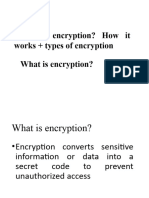0% found this document useful (0 votes)
13 views2 pagesDifference Between Symmetric and Asymmetric Encryption
Symmetric encryption uses a single key for both encryption and decryption, making it faster but requiring secure key sharing, while asymmetric encryption employs a pair of keys (public and private) for secure communication, allowing for open distribution of the public key. Symmetric encryption is suitable for large datasets, whereas asymmetric encryption is ideal for secure communication over untrusted networks. Each method has its own advantages and disadvantages, impacting their use cases and efficiency.
Uploaded by
maromomaniCopyright
© © All Rights Reserved
We take content rights seriously. If you suspect this is your content, claim it here.
Available Formats
Download as DOCX, PDF, TXT or read online on Scribd
0% found this document useful (0 votes)
13 views2 pagesDifference Between Symmetric and Asymmetric Encryption
Symmetric encryption uses a single key for both encryption and decryption, making it faster but requiring secure key sharing, while asymmetric encryption employs a pair of keys (public and private) for secure communication, allowing for open distribution of the public key. Symmetric encryption is suitable for large datasets, whereas asymmetric encryption is ideal for secure communication over untrusted networks. Each method has its own advantages and disadvantages, impacting their use cases and efficiency.
Uploaded by
maromomaniCopyright
© © All Rights Reserved
We take content rights seriously. If you suspect this is your content, claim it here.
Available Formats
Download as DOCX, PDF, TXT or read online on Scribd
/ 2





















































































